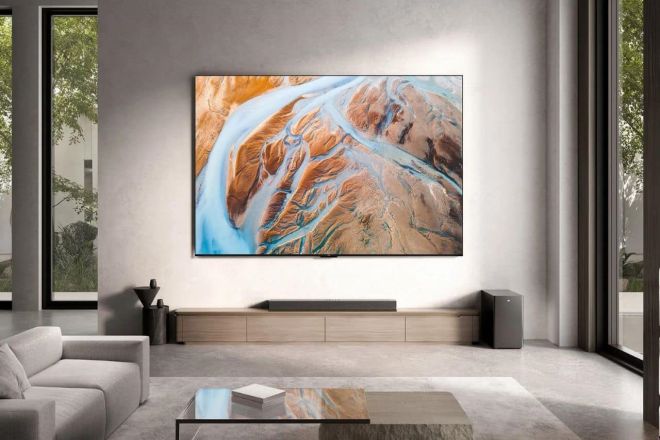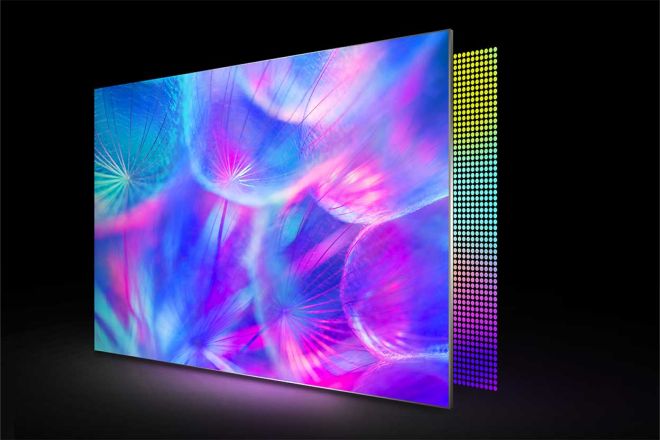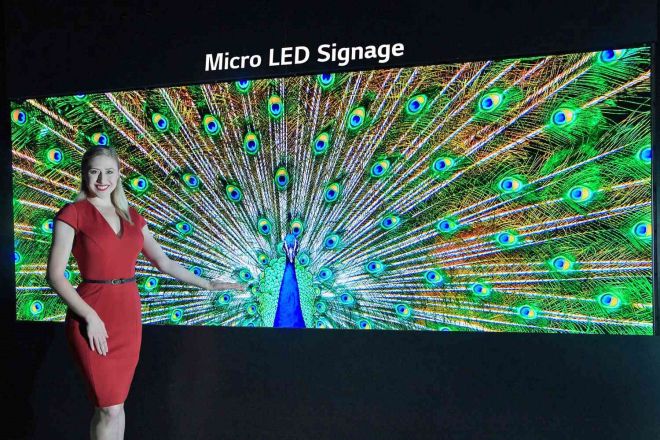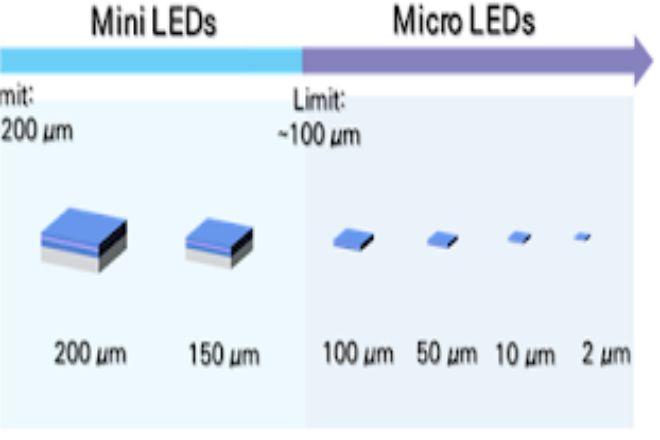Introduction

Mini LED display and Micro LED display, as the latest achievements of LED display technology, are leading a new round of revolution in display technology. These two technologies not only achieve significant improvements in key indicators such as brightness, contrast, and color performance but also show great potential in terms of power consumption, lifespan, and application scenarios.
This article will deeply explore the differences between Mini LED displays and Micro LED displays, from display principles, technical details, and performance to application fields, comprehensively analyze the similarities and differences between these two cutting-edge technologies, and unveil their mysteries for you. Look to the bright future of display technology.
1. What is a Mini LED display

Imagine if we turned the big light bulbs at home into many small, sparkling “beans” and then densely arranged them together to form a huge, super bright light panel. This is the basic idea for a Mini LED display!
The secret of the Mini LED display is its backlight module. This module is like a big stage, and the Mini LED lamp beads are the small light bulbs on the stage. However, these small light bulbs are not simply on or off. They are controlled through a technology called “full matrix zone dimming.”
1). Full matrix zone dimming:
If we divide the stage into many small pieces, each piece can control the brightness and color independently. In this way, when we want to perform a scene, we can light up different areas with different brightness to create different atmospheres according to the needs of the plot.
This is how the Mini LED display works. It divides the screen into many small areas, and the brightness of each area can be adjusted according to the needs of the picture.
For example, when we watch a movie, some places are very dark (such as night scenes), and some places are very bright (such as daytime scenes). The Mini LED display can dynamically adjust the brightness of each area based on these changes, making dark areas darker and bright areas brighter, thereby reducing light leakage and improving contrast and image layering.
2). Features of Mini LED display:
Ultra-small lamp beads: Mini LED makes traditional LED lamp beads ultra-small, dozens of times smaller or even smaller. In this way, we can put more lamp beads in the same area.
- High-density arrangement:
These ultra-small lamp beads are closely arranged together to form a dense array of lamp beads. It’s like a road paved with many small stones. The more stones there are, the smoother and more delicate the road will be.
- High precision and high contrast:
Because there are many dense lamp beads, the Mini LED display can display very detailed images with more vivid colors and higher contrast. This is like the difference between watching high-definition TV and watching old TV. The picture of high-definition TV is clearer, and the colors are more realistic.
2. What is a Micro LED display

Imagine if we could make every pixel on the mobile phone screen super small, so small that the gaps between them are almost invisible. How clear and realistic would the picture be? This is the miracle that the Micro LED display brings us.
The production process of Micro LED display is like super fine hand work. First, workers will use special tools to cut LED chips into ultra-small micro-LEDs (μLEDs).
Then, they used a technology called “batch transfer” to accurately place these tiny bits on the circuit substrate and arrange them neatly. Each little dot corresponds to a pixel on the screen, and they work together to form the beautiful picture we see.
1). The magic of Micro LED displays:
- Micron-level pixels:
Micro LED displays have pixels that are micron-level in size, which is between 1 and 10 microns. This is many times thinner than a hair! Such small pixels allow us to put more pixels on the same screen, and the picture will naturally be more delicate.
- Independent light emission:
Each Micro LED pixel can emit light on its own and does not need to rely on backlight like other displays. It’s like every little light bulb has its own switch. It lights up when it wants and goes out when it wants. It is completely unaffected by the surroundings.
- Ultra-high resolution and color saturation:
Because the pixels are extremely small and numerous, Micro LED displays can easily reach 4K, 8K, or even higher resolutions. Moreover, each pixel can emit pure light from the three primary colors of red, green, and blue, so the colors are super full and super accurate, just like they were taken directly from nature.
- Pixel spacing:
The pixel spacing of Micro LED displays is so small that our eyes can barely see the gaps between them. This way, the image appears to be cut out of a single piece without any grainy or jagged edges.
- Long life and low power consumption:
Micro LED not only has good color and high brightness but is also extremely durable and energy-saving. They maintain stable brightness and color performance over a long period of time, consume very little energy, and generate very little heat.
This means we can enjoy a high-quality visual feast for a long time without worrying about the phone or TV overheating or draining the battery too quickly.
3. Performance comparison: Mini LED vs Micro LED
When discussing the performance of display technology, Mini LED and Micro LED each show impressive advantages. Both technologies are constantly improving our visual experience, but they have obvious differences in terms of brightness, contrast, color performance, power consumption, and lifespan.
1). Brightness and Contrast:
- Mini LED:
This technology uses a large number of densely arranged Micro LED beads to form a backlight array, which greatly improves the brightness and contrast of the screen. This design allows the Mini LED display to maintain excellent display effects in bright environments, reducing the problems of reflection and glare.
- Micro LED:
In terms of brightness, Micro LED has reached a new height. Its brightness far exceeds that of a Mini LED and is even 30 times higher than that of an OLED. At the same time, the contrast of Micro LED is also extremely good, able to present deeper blacks and more vivid colors, making the image display effect clearer and more delicate.
2). Color performance:
- Mini LED:
The color performance of Mini LED has far surpassed traditional LCD technology, approaching or even surpassing OLED in some aspects. Its backlight color adjustment is more refined and can display richer color levels, making the picture more vivid and lifelike.
- Micro LED:
In terms of color saturation, Micro LED has reached an astonishing level. Generally, its color saturation can exceed 120% NTSC, which means it can present more brilliant and full colors, making every detail in the picture more vivid and moving.
3). Power consumption and lifespan:
- Mini LED:
Mini LED also performs well in terms of power consumption. Especially at lower brightness, its power consumption is much lower than LCD and OLED, helping to extend the battery life of the device.
- Micro LED:
The advantage of Micro LED in power consumption is even more obvious. Its power consumption is extremely low, only about 10% of LCD and about 50% of OLED. This means that under the same conditions, Micro LED can use energy more efficiently and reduce energy consumption.
At the same time, the service life of Micro LED is also extremely long, reaching more than 100,000 hours, far exceeding other display technologies.
4.Application fields

With the rapid development of display technology, Mini LED and Micro LED displays are gradually penetrating into various application fields due to their unique performance advantages, bringing users an unprecedented visual experience.
- Mini LED display
Mini LED displays are ideal for large-screen TVs and high-end monitors with their high brightness and contrast ratio. In the fields of commercial display and public information release, Mini LED’s high performance is equally outstanding.
Whether it is a giant-screen advertisement in a shopping mall, a flight information display at an airport, or an outdoor large LED screen, Mini LED can ensure that clear and bright images are presented under various light conditions, effectively attracting the audience’s attention.
In addition, Mini LED’s high color saturation and rich color levels also make it shine in art exhibitions, stage performances, and other occasions. Artists and designers can take advantage of the high performance of Mini LED displays to create more vivid and realistic visual effects, bringing an immersive viewing experience to the audience.
- Micro LED display
Micro LED displays have become the darling of high-end TVs, displays, and small technology products due to their ultra-high resolution and brilliant colors. In the high-end TV market, Micro LED is gradually changing consumers’ viewing habits with its excellent picture quality and extremely low power consumption.
At the same time, due to its self-luminous properties and high stability, Micro LED displays are also very suitable for use in wearable devices and mobile devices. Whether it is smart watches, VR glasses, or smartphones, Micro LED can provide clear, delicate, and full-color display effects, allowing users to enjoy a high-quality visual experience at any time and anywhere.
In addition, the customization characteristics of Micro LED displays also provide broad space for their application in specific fields. For example, in professional fields such as medical imaging and aerospace, Micro LED can be customized and designed according to actual needs to meet strict requirements for image quality, size, and weight.
Conclusion
Mini LED and Micro LED are two cutting-edge representatives of LED display technology, each showing unique advantages in display principles, technical details, performance, and application fields.
Although both face certain challenges at this stage, with the continuous development and improvement of technology, they will surely show broader application prospects in different fields and inject new vitality into the development of display technology.
Finally, if you want to know more information about LED displays, please contact us
